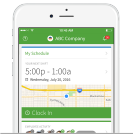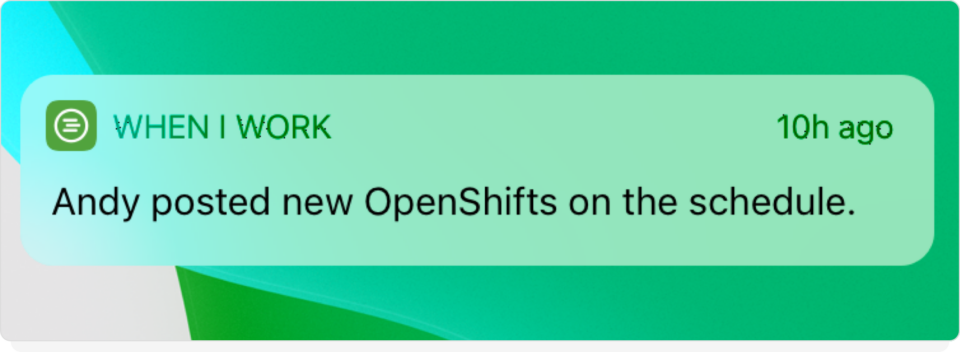Self Scheduling: Everything Managers Should Know
Try When I Work for free
From its core concept to its myriad benefits, this article highlights the transformation self scheduling can bring to businesses and employees alike, backed by real-world examples and practical implementation steps.
When I Work is a leader in shift-based employee scheduling, so we’ve seen firsthand how self scheduling can change a business for the better. Our employee scheduling software is designed to make self scheduling easy for managers and workers, making everyone happy and successful at work.
For business owners, the only constant is change.
You have to get creative, and be ready to shift gears, on just about everything. Customer demand waxes and wanes, and depending on the industry you’re in, scheduling employees adds a layer of complexity to your daily tasks.
This is where self scheduling comes into the conversation.
Key takeaways
- Self scheduling offers mutual flexibility, allowing managers swift scheduling and employees more control over their shifts.
- The practice has led to fewer no-shows, an increase in productivity, and serves as an attractive recruitment and retention tool.
- Numerous industries, from healthcare to retail, have adopted self scheduling, particularly post-COVID.
- Implementation requires deciding on scheduling types, choosing the right tools, and establishing guidelines.
- Despite any challenges, the tangible benefits of self scheduling make it a lasting trend in the evolving business landscape.
Ready to get started right now and save up to 15 hours a week on employee scheduling—all while giving your employees the flexibility of self scheduling? Try When I Work for free today!
What is self scheduling?
Self scheduling offers flexibility to both employees and employers. Managers determine what the schedule requires based on customer traffic and other factors. Instead of assigning specific shifts, employees are allowed to choose what shifts they want, or to trade shifts with others.
This does two things:
- It allows managers to make schedules faster with less fuss.
- It allows employees more control over their lives.
There were large increases in the use of self scheduling in When I Work customers during the pandemic. And the trend has stuck around because employers found that it boosts employee morale, reduces no-shows, makes employees more accountable, and is considered a competitive advantage when hiring new workers.
How self scheduling works
Self scheduling begins with whomever handles the schedule. They define the shifts they want filled. Depending on the business or industry, they may set certain qualifications or requirements for some shifts.
When the shifts are created, the scheduler alerts the employees.
Employees can hop in and select the shifts they want. They can communicate between each other to trade shifts as desired. Any empty shifts that need to be filled can always be assigned later, after employees have selected what they want.
Employees can choose shifts that fit their lives, whether based on their schedule, the hours they can physically handle working, qualifications, or overtime considerations. When using an automated system like When I Work, you can set limits on employees so that, for example, they don’t rack up overtime.
Take When I Work customer Gold Fish Swim School for example. They use shift templates to save time building the schedule each week, but when there’s a special event, the General Manager simply adds OpenShifts to his schedule and lets his employees know. Those who want to get a few extra hours just pop into the schedule and claim those shifts, giving him full coverage.
Benefits of self scheduling
Your employees benefit the most, as self scheduling is part of a healthy work-life balance, which has always been a concern for employees and may be even more so if they’ve had a taste for working from home or with greater flexibility.
- Flexibility. For employers, the beauty of self scheduling is that it allows you to have maximum flexibility in operating your business as demand or need shifts.
- Fewer problems with no-shows. When employees are choosing their own schedules, they are more likely to show up for the shift. No-shows happen for many reasons, including scheduling conflicts, a desire to avoid working with specific people, and illness; self scheduling allows employees to swap and trade to keep those types of things from factoring in.
- Increase in productivity. We each have different times of the day when we’re more productive. Employees can choose the schedule that matches their most productive time, whether they’re morning people or night owls.
- Good for recruitment and retention. The hiring process is notoriously tricky. Self scheduling can be seen as a benefit to potential employees. In that way, it is a recruiting and retention tool.
While you’ll have to keep an eye out for employees who might game the system to get the best shifts and cause division among staff, self scheduling solves most of the scheduling headaches often felt by managers and staff.
Start your free 14-day trial of When I Work! Click here to start scheduling your employees today.

Many industries already use self scheduling
Self scheduling had already become common in the healthcare industry. It has helped reduce nurse turnover costs by serving as a recruitment and retention tool. When done right, there are fewer holes in the schedule, meaning medical centers don’t have to rely on agency nurses as much. This helps reduce healthcare costs and improve consistency in patient care.
It’s not just the healthcare industry using self scheduling—many industries use self scheduling, including:
- telecommunications
- financial services
- travel
- food services
- retail (cashier and stock clerk) and service.
Dustin James, from When I Work customer Event & Media Tech, uses self scheduling to fill his need for audio/visual contractors every day. “We could get a request today, looking for people at 5 p.m. tonight, and it saves us a ton of time. I can produce 20 shifts in a couple minutes, offer them up, and then get them filled up in a matter of minutes.”
Just about anything with staggered or shift work has taken advantage of the approach.
As you can see, self scheduling is gaining popularity as the years go on. Here’s how you can jump in.
How can I get started with self scheduling?
Before starting, you need to know what kind of schedule you’ll be offering your employees.
- Split shifts divide a full shift into parts throughout the day.
- Flex time gives employees leeway in when they start and stop.
- A results-only focus is less about the total time and more about completing productivity goals.
- Alternative schedules are outside of the typical 9-to-5 work day.
What approach to your schedule have you traditionally used? Do you need to keep that and simply offer employees the opportunity to choose which shift, or could you change your standard schedule to one of these other approaches?
Next, choose the tools you will use. In the past, paper sign-up sheets were used, but if you weren’t working the day the shifts were posted, you either had to come in on your day off or get stuck with shifts no one wanted. Apps like When I Work make it simple for you to notify employees the shifts are available. Employees can view, claim, swap shifts, and talk to each other regarding the schedule from their mobile device.

Determine any rules or guidelines necessary to deal with unfilled shifts, employees who request back-to-back shifts, or even rewards that might incentivize unpopular shifts.
If you’re not ready to dive completely into self schedule, start small. Offer a flexible schedule on Fridays, maybe, and see how that works.
And most importantly, pay attention to what’s happening near and far. Talk to your team. Ask them how it’s working. Look for any trouble spots like employees gaming the system (as mentioned earlier), or shifts that no one wants.
The benefits for both employers and employees are real and have been experienced in not only actual operation, but in operation during stressful times. Self scheduling has proven itself to be a powerful tool.
Start scheduling with When I Work
As businesses learned to quickly adapt to unknown environments during COVID-19, they saw firsthand what changes made sense to keep going forward.
Now, years later, self scheduling is still around. The benefits for both employers and employees are real and have been experienced in not only actual operation, but in operation during stressful times. Self scheduling has proven itself to be a powerful tool.
Ready to increase shift coverage while boosting employee morale? Use flexible self scheduling—it’s easy with When I Work. Sign up for your free trial today!
Self scheduling FAQs
Q: What is self scheduling?
A: Self scheduling is a method that offers flexibility to both employees and employers, where instead of managers assigning specific shifts, employees are allowed to choose their preferred shifts or trade them with others.
Q: Why has self scheduling gained prominence in recent years?
A: In the wake of the COVID-19 pandemic, businesses have sought greater flexibility to adapt to changing conditions. Self scheduling has grown as it allows businesses to more efficiently manage schedules and provides employees with more control over their work lives.
Q: How does self scheduling benefit businesses?
A: Self scheduling offers businesses increased flexibility, leads to fewer no-shows as employees pick shifts they can commit to, boosts productivity by allowing employees to work during their most productive hours, and serves as a recruitment and retention tool.
Q: Are there industries where self scheduling is particularly common?
A: Yes, self scheduling has become common in the healthcare sector, reducing nurse turnover and healthcare costs. Due to COVID-19’s influence, many industries, including telecommunications, financial services, and retail, have also adopted the approach.
Q: How can a business implement self scheduling?
A: Businesses looking to implement self scheduling should first decide the type of schedule they’ll offer (like split shifts or flex time). Then, they can use tools like apps to post shifts, allowing employees to view, claim, and swap shifts from their devices. It’s also important to set rules and guidelines for the process and monitor its effectiveness.
Q: Is there a concern about employees abusing the self scheduling system?
A: Yes, there might be instances where employees try to get the best shifts consistently, which could cause division among staff. However, with proper monitoring and guidelines in place, many scheduling challenges can be addressed effectively.






